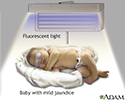Bili lights
Phototherapy for jaundice; Bilirubin - bili lights; Neonatal care - bili lights; Newborn care - bili lights
Bili lights are a type of light therapy (phototherapy) that is used to treat newborn jaundice. Jaundice is a yellow coloring of the skin and eyes. It is caused by too much of a yellow substance called bilirubin in the blood. Bilirubin is created when the body replaces old red blood cells with new ones.
Information
Phototherapy involves shining fluorescent light from the bili lights on bare skin. A specific wavelength of light can break down bilirubin into a form that the body can get rid of through the urine and stools. The light looks blue.
- The newborn is placed under the lights without clothes or just wearing a diaper.
- The eyes are covered to protect them from the bright light.
- The baby is turned frequently.
The health care team carefully notes the infant's temperature, vital signs, and responses to the light. They also note how long the treatment lasted and the position of the light bulbs.
The baby may become dehydrated from the lights. Fluids may be given through a vein during treatment.
Blood tests are done to check the bilirubin level. When the level has dropped enough, phototherapy is complete.
Some infants receive phototherapy at home. In this case, a nurse visits daily and draws a sample of blood for testing.
Treatment depends on 3 things:
- Gestational age
- Bilirubin level in the blood
- Newborn's age (in hours)
In severe cases of increased bilirubin, an exchange transfusion may be done instead.
References
Golden WC, Watchko JF. Neonatal hyperbilirubinemia and kernicterus. In: Gleason CA, Sawyer T, eds. Avery's Diseases of the Newborn. 11th ed. Philadelphia, PA: Elsevier; 2024:chap 72.
Kaplan M, Wong RJ, Burgis JC, Sibley E, Stevenson DK. Neonatal jaundice and liver diseases. In: Martin RJ, Fanaroff AA, Walsh MC, eds. Fanaroff and Martin's Neonatal-Perinatal Medicine. 11th ed. Philadelphia, PA: Elsevier; 2020:chap 91.
Marcdante KJ, Kliegman RM, Schuh AM. Anemia and hyperbilirubinemia. In: Marcdante KJ, Kliegman RM, Schuh AM, eds. Nelson Essentials of Pediatrics. 9th ed. Philadelphia, PA: Elsevier; 2023:chap 62.
Review Date: 11/6/2023





